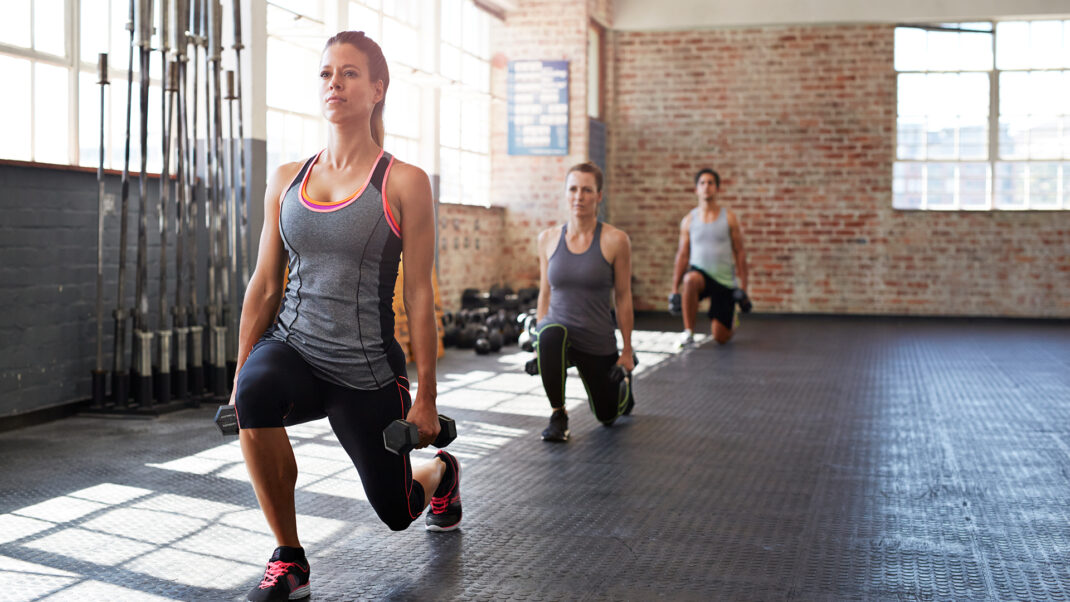A Woman’s Place Is in the Weight Room
Optimize workouts to account for differences in musculature and hormones.

Every day, more women are moving from the cardio room to the weight room. It’s a welcome transition; getting stronger can transform their self-esteem, confidence and self-efficacy.
Supporting your female clients’ strength-training ambitions is fundamental to their long-term success. Women and girls enjoy a wealth of benefits from resistance exercise: reduced injury risk, better cardiovascular health, stronger bones, protection against
diabetes, and less inflammation, to name a few. As more women flock to strength training, however, fitness professionals face a host of challenges. For starters, the research on weight training for women is relatively new, and there are fewer studies on women than there are on men. Also, the physiological differences between genders is either misrepresented or not discussed.
We aren’t that much different. In equally trained men and women, research finds most strength differences result from differences in muscle size, not gender (Bishop, Cureton & Collins 1987). These findings suggest that a man and a woman with the same muscle size should display the same amount of strength. Thus, we can retire terms like “toned” and “girl pushups”—and the pictures of pink dumbbells—because women should and can do the same exercises your male clients do. You, of course, already know this.
You should consider two crucial points, however:
- Women and men have different muscular fiber type compositions, making women less prone to fatigue (Hunter 2014).
- Female sex hormones, especially those involved in the menstrual cycle, can affect program timing and recovery (Sung et al. 2014).
Understanding these differences is pivotal to building programs that will help your female clients achieve muscle growth, strength gains and training success.
Fiber Types in Women vs. Men
Type I and type II. Generally speaking, the skeletal muscles of men are larger than those of women, and, in men, some muscles possess “a greater proportional area of metabolically and functionally faster muscle fibers,” whereas in women there is “a greater proportional area of the ‘slow’ type I fibers” (Hunter 2014). The higher concentration of type I fibers makes women more resistant to muscle fatigue. Men have a higher glycolytic capacity based on their larger concentration of type II fibers, priming males for quick, explosive activities like sprinting and weightlifting.
While muscle fiber type plays a large role, it is important to remember that the tendency to fatigue depends a lot on task conditions, including contraction type, speed and intensity; the muscle group involved; environmental conditions; and state of arousal (Hunter 2014).
Metabolism. The makeup of muscular tissue affects the energy substrates that each gender uses. Women typically carry 6%–12% more fat than men. Women are also better at handling fat and using it for energy during exercise, which spares muscle glycogen and decreases exertion ratings, again playing into fatigue resistance. Additionally, women are more sensitive to insulin across the entire body and are better able to take up glucose (Lundsgaard & Kiens 2014).
Program design. If muscle growth is a female client’s main goal, keep in mind that she is probably more resistant to fatigue than a male client would be. Programming sets in the 6- to 10-rep range seems to yield maximal muscle growth (Schuenke et al. 2012) and maximal increases in strength.
Because women can theoretically handle more work, your general-population clients might benefit from harder-intensity training sessions with supersets and timed rest periods. Consider challenging them to fatigue a little faster than they normally would, since you need to push them beyond their comfort zone to achieve muscle growth.
Sex Hormone Differences
Menstrual cycle. Women’s menstrual hormones fluctuate throughout their cycle, which usually lasts 28 days (hormonal contraceptives and other issues can alter the cycle). Hormonal fluctuations play a huge role in strength training, a reality only recently discussed in academic literature. By opening up this conversation with your female clients, you can tap into their strengths a little more and use biology in their favor (Sung et al. 2014).
The menstrual cycle has four phases:
- menstrual (days 1–5)
- follicular (days 1–13)
- ovulation (day 14)
- luteal (days 15–28).
The luteal phase triggers sharp hormonal changes—progesterone peaks and then plunges, along with estradiol. Hunger increases, moods change suddenly, core temperature rises, and more calories are burned; in fact, basal metabolic rate has been shown to increase by as much as 9% (Webb 1986). In this phase, symptoms of premenstrual syndrome often discourage interest in going to the gym.
The follicular phase, by contrast, is the time for women to really push themselves in hard workouts because estrogen hits its peak at this time, improving mood, energy and strength.
Estrogen vs. testosterone. These sex hormones have the most impact on the relative strength of women and men. Men have much more testosterone, affecting their baseline strength. Thus, men start out stronger with higher absolute strength, but relative strength gains are about the same for both genders.
Estrogen, on the other hand, has proved to have some anabolic and protective effects against various injuries and diseases. Within muscle, estrogen has been shown to influence contractions and postexercise muscle damage by acting as an antioxidant and a stabilizing membrane and by binding to estrogen receptors (Enns & Tidius 2010). Estrogen also has regenerative properties, which is why combining exercise and hormonal therapies can increase lean tissue mass (Velders & Diel 2013).
Program design. Maintain an open dialogue with your female client: Ask how she is feeling and if she would like to disclose the current phase of her menstrual cycle. Explain that while she doesn’t have to push through the bothersome symptoms of the luteal phase, she will benefit from some type of movement.
In the luteal phase, steer clear of high-intensity interval training and avoid going for personal bests or heavy strength sessions. Save these for the follicular phase. The luteal phase is an optimal time for deloading if the client is on a strength program. It’s also a great time for moderate conditioning or low-intensity cardio training.
Optimize periodization around her cycle. For instance, if she usually does strength training three times a week, you might keep the frequency the same during the luteal phase and ramp it up a session or two during the follicular phase (Sung et al. 2014). See “Sample Program Design,” below, for more.
Putting It All Together
Though men and women are different, your approach to strength training should be similar: Optimize physiological differences to produce peak training performance. As a fitness professional, you need to do three things to avoid alienating female clients by suggesting that their strength training programs are somehow inferior to men’s:
- Lead by example. Show pictures, videos and articles of women doing what men (and other women) do. Show what these women’s bodies look like, what they are capable of and how they got there, while also (if you are a female trainer) disclosing the importance of strength training in your own life. You have the power to be a role model and a leader. Be the example, and your female clients will follow.
- Banish biased language. Remove gender-labeled equipment and exercises from your vocabulary: Words like long, lean, toned and girl pushups have no merit or place in this space. This kind of language reinforces the false notion that women require a different type of exercise that will not make them “bulky” or “manly.”
- Make room for self-discovery. Strength training can be scary and intimidating. Women almost never approach weight training wholeheartedly unless they’ve grown up around it. Let your clients draw their own conclusions about the experience—what they like or dislike. Female clients will appreciate having the space to find what they love about moving their bodies in this way. When the motivation comes from within, they will be more likely to stick with the activity and see the benefits of a strong body and mind throughout their entire lives—inside and outside of the gym.
SEX SPECIFICITY AND GENE EXPRESSION
We know that men and women have different quantities of muscle fiber types: Women carry more type I, and men carry more type II, but it is also worth noting how men and women react to resistance training—specifically how their muscles react to the demands—as it relates to gene expression.
When at rest, women’s muscles have a greater transcript abundance of genes involved in fatty acid oxidation and—because of this—females exhibit faster restoration after strength training, whereas males experience more prolonged changes and take longer to recover. Sex specificity, as it relates to gene expression, is suggestive of several signaling pathways and explains the disproportional muscle growth in males as compared with females. Sex differences therefore exist in skeletal muscle both at rest and following a bout of exercise (Liu et al. 2010).
Case study: Jane is 25 years old, has no special indications or complications, and would like to strength train three times a week. She is a former competitive powerlifter but hasn’t competed in over a year. She wants to get stronger in the big three lifts and is aiming to build muscle while maintaining athleticism and overall health. Jane experiences fatigue, bloating and cramps on days 19–22, and while menstruation doesn’t really bother her, ovulation can sometimes be an issue. The following program is built with these things in mind and starts on day 14 to align the harder-intensity days with the follicular phase.
Note: Exercises in the first superset of each day are utilized as warmup movements, but longer warmups are recommended. Main lifts are based on one-repetition maximum (1-RM), accessories on rating of perceived exertion (RPE).
WEEK ONE: Monday–Sunday, days 14–20. Jane is entering ovulation and the luteal phase. This month, ovulation is not bothering her, but she does feel discomfort in the middle of the luteal phase, so this is a time to decrease training intensity and replace some days with light cardio/rest.
DAY ONE
1a. leg lower, 3 × 8
1b. goblet squat, 3 ├ù 5 w/ 3-1-X tempo (X = “explode”)
2. back squat, 4 × 8, 70% of 1-RM; 2-minute rest
3. tempo back squat, 3 ├ù (1+1) x 2 (RPE 6–7); 2-minute rest
4. snatch deadlift, 2 ├ù 4 (RPE 6–7); 90-second rest
5a. single-leg squat to box, 3 ├ù 8–12
5b. leg curl, 3 ├ù 8–12
5c. jump rope, 3 × 30 seconds; 75-second rest at end of superset
DAY TWO
1a. commando rock backs, 3 x 8
1b. pushup rock back, 3 x 5
2. bench press, 4 × 8 at 70% of 1-RM; 2-minute rest
3. close-grip bench press, 3 ├ù 4 (RPE 6–7); 2-minute rest
4. seated upright dumbbell press, 2 × 4; 90-second rest
5a. dumbbell incline bench press, 3 ├ù 8–12
5b. half-kneeling kettlebell shoulder press, 3 ├ù 8–12
5c. side plank, 3 × 30 seconds; 75-second rest at end of superset
DAY THREE
1a. shin box switches, 3 x 5
1b. snapdown to vertical jump, 3 × 5
2. deadlift, 4 × 8 at 70% of 1-RM; 2-minute rest
3. triple-strike deadlift (pause 2 inches from floor, back to floor, pause at knee, back to floor, full pull), 3 × 4 (RPE 6-7); 2-minute rest
4. barbell Romanian deadlift, 2 ├ù 4 (RPE 6–7); 90-second rest
5a. three-point row, 3 ├ù 8–12
5b. lat pulldown, 3 ├ù 8–12
5c. cable face pull, 3 ├ù 10–15; 75-second rest at end of superset
WEEK TWO: Monday–Sunday, days 21–27. Jane is at the end of the luteal phase and will be entering a new cycle. This time can be very case-specific. Jane may still be experiencing discomfort, but, for the most part, the program will continue to intensify.
DAY ONE
1a. leg lower, 3 × 8
1b. goblet squat, 3 × 5 w/ 3-1-X tempo
2. back squat, 5 × 7, 75% of 1-RM; 2-minute rest
3. tempo back squat, 3 ├ù (1+1) x 2 (RPE 7–8); 2-minute rest
4. snatch deadlift, 2 ├ù 4 (RPE 7–8); 90-second rest
5a. single-leg squat to box, 3 ├ù 8–12
5b. leg curl, 3 ├ù 8–12
5c. jump rope, 3 × 30 seconds; 75-second rest at end of superset
DAY TWO
1a. commando rock backs, 3 × 8
1b. pushup rock back, 3 × 5
2. bench press, 4 × 8 at 75% of 1-RM; 2-minute rest
3. close-grip bench press, 3 x 4 (RPE 7–8); 2-minute rest
4. seated upright dumbbell press, 2 × 5; 90-second rest
5a. dumbbell incline bench press, 3 ├ù 8–12
5b. half-kneeling kettlebell shoulder press, 3 ├ù 8–12
5c. side plank, 3 × 30 seconds; 75-second rest at end of superset
DAY THREE
1a. shin box switches, 3 × 5
1b. snapdown to vertical jump, 3 × 5
2. deadlift, 4 × 8 at 75% of 1-RM; 2-minute rest
3. triple-strike deadlift, 3 ├ù 4 (RPE 7–8); 2-minute rest
4. barbell Romanian deadlift, 2 ├ù 4 (RPE 7–8); 90-second rest
5a. three-point row, 3 ├ù 8–12
5b. lat pulldown, 3 ├ù 8–12
5c. cable face pull, 3 ├ù 10–15; 75-second rest at end of superset
WEEK THREE: Monday–Sunday, days 28–6 of cycle. During this week, Jane will be in the menstruation/follicular phase, and strength training may be challenging for her.
DAY ONE
1a. leg lower, 3 × 8
1b. goblet squat, 3 × 5 w/ 3-1-X tempo
2. back squat, 6 × 6 at 80% of 1-RM; 2-minute rest
3. tempo back squat, 3 ├ù (1+1) x 2 (RPE 8–9); 2-minute rest
4. snatch deadlift, 2 ├ù 6 (RPE 8–9); 90-second rest
5a. single-leg squat to box, 3 ├ù 8–12
5b. leg curl, 3 ├ù 8–12
5c. jump rope, 3 × 30 seconds; 75-second rest at end of superset
DAY TWO
1a. commando rock backs, 3 × 8
1b. pushup rock back, 3 × 5
2. bench press, 6 × 6 at 80% of 1-RM; 2-minute rest
3. close-grip bench press, 3 ├ù 4 (RPE 8–9); 2-minute rest
4. seated upright dumbbell press, 2 ├ù 6 (RPE 8–9); 90-second rest
5a. dumbbell incline bench press, 3 ├ù 8–12
5b. half-kneeling kettlebell shoulder press, 3 ├ù 8–12
5c. side plank, 3 x × 30 seconds; 75-second rest at end of superset
DAY THREE
1a. shin box switches, 3 × 5
1b. snapdown to vertical jump, 3 × 5
2. deadlift, 6 × 6 at 80% of 1-RM; 2-minute rest
3. triple-strike deadlift, 3 ├ù 4 (RPE 87–9); 2-minute rest
4. barbell Romanian deadlift, 2 ├ù 6 (RPE 8–9); 90-second rest
5a. three-point row, 3 ├ù 8–12
5b. lat pulldown, 3 ├ù 8–12
5c. cable face pull, 3 ├ù 10–15; 75-second rest at end of superset
WEEK FOUR: Monday–Sunday, days 7–13. Jane is now in the follicular phase, so her program should continue to intensify in both weight and volume, as this is when she is most primed for testing. This is a good week for AMRAPs (doing “as many reps as possible”) or 1-RM testing—in this case, she’ll do AMRAPs testing for the next phase of programming.
DAY ONE
1a. leg lower, 3 × 8
1b. goblet squat, 3 × 5 w/ 3-1-X tempo
2. back squat, 1 × AMRAP at 85% of 1-RM
3. tempo back squat, 3 ├ù (1+1) ├ù 2 (RPE 9–10); 2-minute rest
4. snatch deadlift, 2 ├ù 6 (RPE 9–10); 90-second rest
5a. single-leg squat to box, 3 ├ù 8–12
5b. leg curl, 3 ├ù 8–12
5c. jump rope, 3 × 30 seconds; 75-second rest at end of superset
DAY TWO
1a. commando rock backs, 3 × 8
1b. pushup rock back, 3 × 5
2. bench press, 1 × AMRAP at 85% of 1-RM
3. close-grip bench press, 3 ├ù 4 (RPE 9–10); 2-minute rest
4. seated upright dumbbell press, 2 ├ù 6 (RPE 9–10); 90-second rest
5a. dumbbell incline bench press, 3 ├ù 8–12
5b. half-kneeling kettlebell shoulder press, 3 ├ù 8–12
5c. side plank, 3 × 30 seconds; 75-second rest at end of superset
DAY THREE
1a. shin box switches, 3 × 5
1b. snapdown to vertical jump, 3 × 5
2. deadlift, 1 × AMRAP at 85% of 1-RM
3. triple-strike deadlift, 3 ├ù 4 (RPE 9–10); 2-minute rest
4. barbell Romanian deadlift, 2 ├ù 6 (RPE 8–9); 90-second rest
5a. three-point row, 3 ├ù 8–12
5b. lat pulldown, 3 ├ù 8–12
5c. cable face pull, 3 ├ù 10–15; 75-second rest at end of superset
References
Bishop, P., Cureton, K., & Collins, M. 1987. Sex difference in muscular strength in equally-trained men and women. Ergonomics, 30 (4), 675–87.
Enns, D.L., & Tidius, P.M. 2010. The influence of estrogen on skeletal muscle: Sex matters. Sports Medicine, 40 (1), 41–58.
Hunter, S.K. 2014. Sex differences in human fatigability: Mechanisms and insight to physiological responses. Acta Physiologica, 210 (4), 768-89.
Liu, D., et al. 2010. Skeletal muscle gene expression in response to resistance exercise: Sex specific regulation. BMC Genomics, 11.
Lundsgaard, A.M., & Kiens, B. 2014. Gender differences in skeletal muscle substrate metabolism—molecular mechanisms and insulin sensitivity. Frontiers in Endocrinology, 5, 195.
Schuenke, M.D., et al. 2012. Early-phase muscular adaptations in response to slow-speed versus traditional resistance-training regimens. European Journal of Applied Physiology, 112 (10), 3585–95.
Sung, E., et al. 2014. Effects of follicular versus luteal phase-based strength training in young women. SpringerPlus, 3 (668).
Velders, M., & Diel, P. 2013. How sex hormones promote skeletal muscle regeneration. Sports Medicine, 43 (11), 1089–1100.
Webb, P. 1986. 24-hour energy expenditure and the menstrual cycle. The American Journal of Clinical Nutrition, 44 (5), 614–19.





